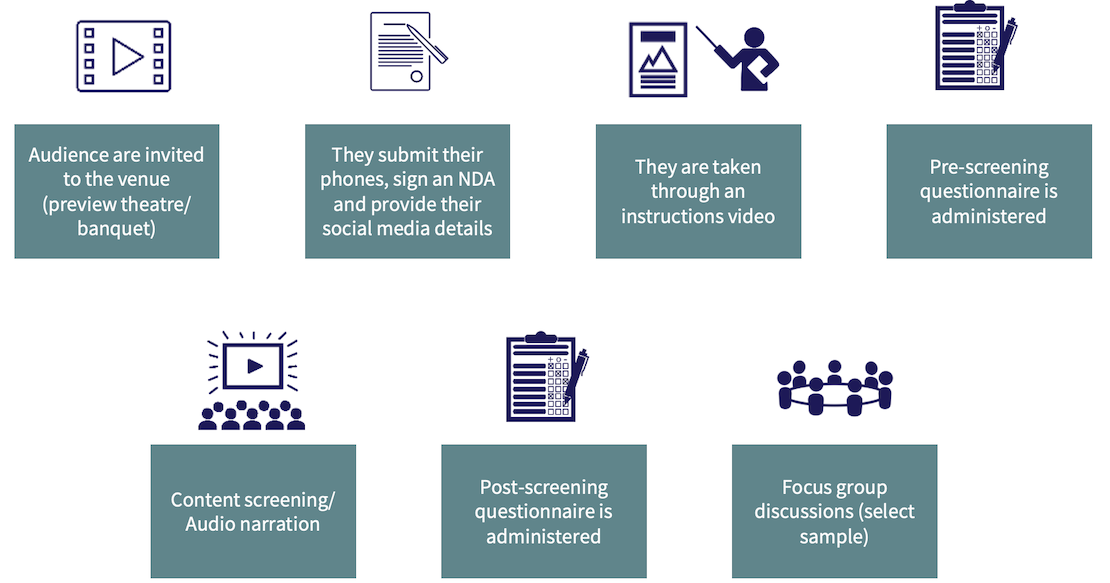


By Our Insights Desk
Having pioneered Content Testing in India for over a decade, we often get asked questions from our prospective clients about the intricacies of the process. In this multi-part series (one edition every month), we attempt to answer some of the most common questions we get asked around the various aspects related to Content Testing.
This is the second edition in this series. Refer to the first edition for more such queries around Content Testing.
1. How do you test a screenplay, when no video content is available?
We test scripts (at a step outline or screenplay stage) in the 'radio theatre' format, whereby the script is narrated using a voice recording with a professional voice-over artists. A narration of this nature retains key plot points and dialogues, and is typically about 60-75 minutes in duration for a film or a web-series, and about 15-30 minutes in duration for a GEC show. We do not test animation content or non-fiction content in this format, as video stimulus is essential for those tests. In case of remakes, we sometimes prefer testing the original film/show with subtitles, as a substitute to the radio theatre format. The degree of changes in the adaptation vis-à-vis the original is a factor of consideration in this decision.
We have often been asked if this method of script testing can give accurate results. Audience react to characters, emotions and key plot points, and have the ability to visualise the film or the show in their minds when they listen to an audio narration. Our audio narrations are written and recorded by us, to ensure a standardised format of writing and story-telling, which we have established based on about 200 projects of this nature. For 90% screenplay testing projects, test OPR (Ormax Power Rating) has been within 7 points of actual OPR, compared to 5 points for video testing, highlighting that screenplay testing using an audio stimulus is almost as effective as video testing in a typical scenario. For more on OPR, read the first edition of our Content Testing FAQs linked above.
2. How do you test a series or a TV show, where the length of content is several hours?
For web-series, we typically test the first three episodes, which is a fair indicator of performance in the real world, where audiences decide on whether to continue watching a series after watching 2-3 episodes.
For GEC shows, a concept narration of 15-30 minutes is typically used, which builds the show's premise, key characters, and the storyline over the first 3-6 months. Even when the first episode (pilot) is available in video format, we follow the screening of the episode with this concept narration, to capture the longer arc of the show, covering 3-6 months of story.
3. Where is Content Testing research conducted?
For theatrical films being tested in the video format (rough cut), Content Testing research is conducted in a preview theatre, with a capacity of 40-60 seats. In cities where such a facility is not available, a private venue, such as a banquet hall in a hotel, is adapted to replicate the theatrical experience, with a big screen and good quality audio equipment.
For web-series, TV shows and film scripts, commercial venues like banquet halls are used, with quality seating, video and audio devices. Large-screen flat TVs are used to play videos in such cases. Typically batch sizes are about 20-30 audience in such cases.
4. What happens on the day of the test screening? What are the various processes that happen?
The multiple processes that happen on the day of the test screening, are depicted in the chart below:

5. How do you decide the composition for the test audience, such as the proportion by gender, age, markets, etc.? Does this vary by format/genre of content?
The principle of testing the property among the 'regular category audience' of the medium is applied on most occasions. For example, for theatrical content, Ormax Media’s report Sizing The Cinema: 2024 is used for gender and age breakup, based on the profile of regular theatre-goers in the respective languages. Some customization to the genre of the film based on title-level footfalls data of benchmark films available with Ormax is incorporated, if needed.
Similarly, for OTT shows and films, gender & age split in the recommended research design is based on their proportion in the universe of 15+ audience watching streaming original content. In this universe, the proportion of SVOD:AVOD audience is 61:39, which is also a recommended mix in the sample, unless the platform has a specific strategic requirement to the contrary.
However, these proportions can be customized to align them to the platform’s target audience, and to the expected TG of the show, based on genre of the show (like horror, young adult content, etc.) and other similar aspects.
Number of markets is determined by cost considerations, and typically range from two to five. Ormax recommends a market mix based on the content's genre and marketing potential, which is then discussed and locked after discussion with the studio/platform/channel.
6. Do you need the final product, with the final VFX and background music, for video testing?
In most cases, we test video content in parallel with the post production process. Doing this ensures that the producer/platform has sufficient time to incorporate changes before the release of the property. A rough edit, with reference background music and work-in-progress VFX, is testable in most cases. As long as the material is comprehensible by the audience, test results tend to reflect an accurate picture. We will recommend a test only if the content passes our internal assessment of being research-ready.
7. How much time does it take to complete the research and get the results?
Depending upon the sample size and the number of markets, it can take 2-4 weeks from commissioning the project to receiving the final report.
8. What is the cost of conducting a Content Testing research?
For the value it offers, cost of Content Testing research is very low, typically being 0.25-0.75% of the cost of production of content. The cost depends on the sample size, the choice of markets & TG, the type of research (video vs. script, film vs. OTT vs. TV, etc.), and other such factors. A project can cost between ₹6-25 lac ($7,000-30,000), depending on these factors.
9. Test screenings have been done informally by many producers over the years. How is the Ormax method different?
Informal test screenings, including friends & family screenings, are plagued by sample selection bias. In fact, such methods can do more harm than good, as they can paint a false picture, which is not aligned to the feedback of the 'real audience'.
Apart from being a statistically-rigorous process, our research tools use our proprietary forecasting algorithms that enable sound business decisions, which make them a lot more scientific and rigorous than informal methods. Our analysts work on Content Testing projects for a living, and bring their cumulative experience across several projects on board every new project.
10. Can a maker attend the research to get real-time feedback on their content?
We welcome and encourage producers, directors and writers to attend the research, experience the content with the audience, and watch the focus group discussions using a CCTV setup. However, we need to be mindful of following certain protocols in this regard, especially if the people attending are faces recognizable by the audience. In any case, we provide video recordings of all focus group discussions to the commissioning producer.
We understand that you may have other queries too. Watch out this space for the next edition of the FAQs on Content Testing. Additionally, we will be happy to connect with you and answer your more urgent queries.

Ormax Cinematix's FBO: Accuracy update (November 2025)
This edition of our monthly blog summarises Ormax Cinematix's box office forecasts (FBO) for all major November 2025 releases vis-à-vis their actual box-office openings

From CTV to Micro Dramas: India's fascinating OTT spectrum
The simultaneous rise of Connected TV and Micro Drama audiences in India over the last year highlights how the Indian OTT market is expanding at both the premium and the mass ends simultaneously

Product update: Content testing for the horror genre
Based on our accumulated audience insights, we are introducing genre-specific drivers for horror films and series in our content testing tools, Ormax Moviescope and Ormax Stream Test
Subscribe to stay updated with our latest insights
We use cookies to improve your experience on this site. To find out more, read our Privacy Policy